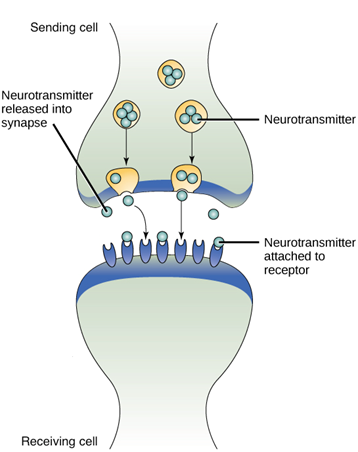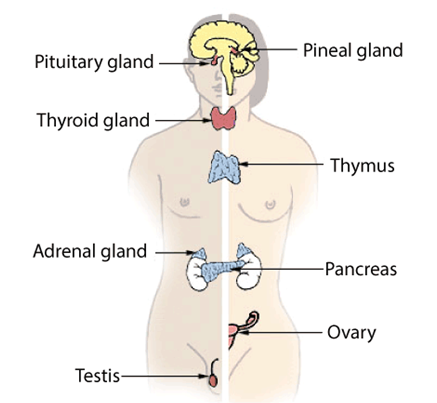CELL SIGNALLING
Cell Signaling.
Cells typically communicate using chemical signals. These chemical signals, which are proteins or other molecules produced by a sending cell, are often secreted from the cell and released into the extracellular space. There, they can float over to neighboring cells.
Not all cells can “hear” a particular chemical message. To detect a signal (that is, to be a target cell), a neighbor cell must have the right receptor for that signal. When a signaling molecule binds to its receptor, it alters the shape or activity of the receptor, triggering a change inside of the cell. Signaling molecules are often called ligands, a general term for molecules that bind specifically to other molecules (such as receptors).
The message carried by a ligand is often relayed through a chain of chemical messengers inside the cell. Ultimately, it leads to a change in the cell, such as alteration in the activity of a gene or even the induction of a whole process, such as cell division. Thus, the original intercellular (between-cells) signal is converted into an intracellular (within-cell) signal that triggers a response.
FORMS OF SIGNALING
Cell-cell signaling involves the transmission of a signal from a sending cell to a receiving cell. However, not all sending and receiving cells are next-door neighbors, nor do all cell pairs exchange signals in the same way.
There are four basic categories of chemical signaling found in multicellular organisms:
Paracrine
signaling
Autocrine
signaling
Endocrine
signaling
Signaling
by direct contact.
The main difference between the different categories of signaling is the distance that the signal travels through the organism to reach the target cell.
Paracrine signaling
Often, cells that are near one another communicate
through the release of chemical messengers (ligands that can diffuse through
the space between the cells). This type of signaling, in which cells
communicate over relatively short distances, is known as paracrine
signaling.
Paracrine signaling allows cells to coordinate activities with their neighbors. Although they're used in many different tissues and contexts, paracrine signals are especially important during development, when they allow one group of cells to tell a neighboring group of cells what cellular identity to take on.
Synaptic signaling
One unique example of paracrine signaling is synaptic signaling, in which nerve cells transmit signals. This process is named for the synapse, the junction between two nerve cells where signal transmission occurs. When the sending neuron fires, an electrical impulse moves rapidly through the cell, traveling down the axon. When the impulse reaches the synapse, it triggers the release of ligands called neurotransmitters, which quickly cross the small gap between the nerve cells. When the neurotransmitters arrive at the receiving cell, they bind to receptors and cause a chemical change inside of the cell (often, opening ion channels and changing the electrical potential across the membrane).
The neurotransmitters that are released into the chemical synapse are quickly degraded or taken back up by the sending cell. This "resets" the system so the synapse is prepared to respond quickly to the next signal.
AUTOCRINE SIGNALING
In autocrine signaling, a cell signals to itself, releasing a ligand that binds to receptors on its own surface. It plays an important role in many processes. For instance, autocrine signaling is important during development, helping cells take on and reinforce their correct identities. Autocrine signaling is important in cancer and is thought to play a key role in metastasis. In many cases, a signal may have both autocrine and paracrine effects, binding to the sending cell as well as other similar cells in the area.
ENDOCRINE SIGNALING
When cells need to transmit signals over long distances, they often use the circulatory system as a distribution network for the messages they send. In long-distance endocrine signaling, signals are produced by specialized cells and released into the bloodstream, which carries them to target cells in distant parts of the body. Signals that are produced in one part of the body and travel through the circulation to reach far-away targets are known as hormones.
ENDOCRINE SIGNALING
In humans, endocrine
glands that release hormones include
The Thyroid
The Hypothalamus
The Pituitary
The Gonads (Testes
and Ovaries)
The Pancreas.
Each endocrine gland
releases one or more types of hormones, many of which are master regulators of
development and physiology.
ENDOCRINE SIGNALING
For example, the pituitary releases growth hormone (GH), which promotes growth, particularly of the skeleton and cartilage. Like most hormones, GH affects many different types of cells throughout the body. However, cartilage cells provide one example of how GH functions: it binds to receptors on the surface of these cells and encourages them to divide.
Signaling through
cell-cell contact
Gap junctions in
animals and plasmodesmata in plants are tiny channels that directly connect
neighboring cells.
These water-filled
channels allow small signaling molecules, called intracellular mediators,
to diffuse between the two cells.
Small molecules and
ions are able to move between cells, but large molecules like proteins and DNA
cannot fit through the channels without special assistance.
Signaling Through Complementary Proteins
In one form of direct signaling, two cells may bind to one another because they carry complementary proteins on their surfaces. When the proteins bind to one another, this interaction changes the shape of one or both proteins, transmitting a signal. This kind of signaling is especially important in the immune system, where immune cells use cell-surface markers to recognize “self” cells (the body's own cells) and cells infected by pathogens.
Signaling Through Gap Junctions
The transfer of signaling molecules transmits the current state of one cell to its neighbor. This allows a group of cells to coordinate their response to a signal that only one of them may have received. In plants, there are plasmodesmata between almost all cells, making the entire plant into one giant network.










Comments
Post a Comment